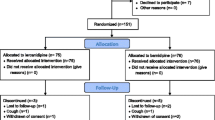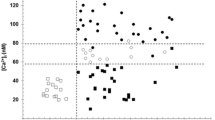Abstract
Objective
Carvedilol is a nonselective β- and α1-receptor antagonist with additional antioxidant properties in vitro. In this study, we assessed the antioxidative potential of carvedilol in cell culture and in antihypertensive doses in healthy men.
Methods
In vitro, human cultured endothelial cells were treated with native low-density lipoprotein (LDL), oxidized LDL or tumor necrosis factor (TNF)α in the absence and in the presence of carvedilol (40 µM); 8-iso-prostaglandin (PG)F2α, as parameter of oxidative stress, was determined in the supernatants. In a double-blind, randomized, cross-over study, 17 healthy men received 25 mg carvedilol b.i.d., 100 mg metoprolol b.i.d. or placebo for 6 days. After each treatment, systemic oxidative stress was assessed by measuring urinary excretion of 8-iso-PGF2α and 2,3-dinor-5,6-dihydro-8-iso-PGF2α, and the plasma concentration of 3-nitrotyrosine by means of gas chromatography-tandem mass spectrometry. In addition, thiobarbituric acid-reactive substances (TBARS) in plasma were assessed using spectrophotometry.
Results
Native LDL and oxidized LDL induced 8-iso-PGF2α production in endothelial cells. Carvedilol significantly reduced this effect (e.g., for oxidized LDL: 2.66±0.22 pg vs 1.46±0.14 pg 8-iso-PGF2α per µg protein, P<0.05). In healthy volunteers, carvedilol and metoprolol markedly decreased blood pressure and heart rate, but had no statistically significant effect on any indicator of oxidative stress measured. Remarkably, a trend toward reduction of urinary isoprostanes and 3-nitrotyrosine in plasma by both active treatments was observed, suggesting a non-specific antioxidative effect by β blockade.
Conclusions
In vitro, the antioxidative potential of carvedilol was confirmed. In healthy men, antihypertensive doses of carvedilol exert no specific inhibition of oxidative stress.

Similar content being viewed by others
References
Yue T-L, McKenns PJ, Lysko PG, Gu JL, Lysko KA, Ruffolo RR, Feuerstein GZ (1994) SB 211475, a metabolite of carvedilol, a novel antihypertensive agent, is a potent antioxidant. Eur J Pharmacol 251:237–243
Feuerstein G, Shusterman NH, Ruffolo RR (1997) Carvedilol update IV: prevention of oxidative stress, cardiac remodeling and progression of congestive cardiac failure. Drugs Today 33:453–473
Aruoma OI (1997) Scavenging of hypochlorous acid by carvedilol and ebselen in vitro. Gen Pharmacol 28:269–272
Maggi E, Marchesi E, Covini D, Negro C, Perani G, Bellomo G (1996) Protective effects of carvedilol, a vasodilating beta-adrenoceptor blocker, against in vivo low density lipoprotein oxidation in essential hypertension. J Cardiovasc Pharmacol 27:532–538
Giugliano D, Acampora R, Marfella R, De Rosa N, Ziccardi P, Ragone R, De Angelis L, D’Onofrio F (1997) Metabolic and cardiovascular effects of carvedilol and atenolol in non-insulin-dependent diabetes mellitus and hypertension. A randomized, controlled trial. Ann Intern Med 126:955–959
Dandona P, Karne R, Ghanim H, Hamouda W, Aljada A, Magsino CH Jr (2000) Carvedilol inhibits reactive oxygen species generation by leukocytes and oxidative damage to amino acids. Circulation 101:122–124
Arumanayagam M, Chan S, Tong S, Sanderson JE (2001) Antioxidant properties of carvedilol and metoprolol in heart failure: a double-blind randomized controlled trial. J Cardiovasc Pharmacol 37:48–54
Gutteridge JMC, Halliwell B (1990) The measurement and mechanism of lipid peroxidation in biological systems. Trends Biochem Sci 15:129–135
Roberts LJ, Morrow JD (2002) Products of the isoprostane pathway: unique bioactive compounds and markers of lipid peroxidation. Cell Mol Life Sci 59:808–820
Halliwell B (1997) What nitrates tyrosine? Is nitrotyrosine specific as a biomarker of peroxynitrite in vivo? FEBS Lett 411:157–160
Davi G, Alessaridrini P, Mezetti A (1997) In vivo formation of 8-epi-prostaglandin F2 alpha is increased in hypercholesterolemia. Arterioscler Thromb Vasc Biol 17:3230–3235
Gniwotta C, Morrow JD, Roberts LJ, Kuhn H (1997) Prostaglandin F2-like compounds, F2-isoprostanes, are present in increased amounts in human atherosclerotic lesions. Arterioscler Thromb Vasc Biol 17:3236–3241
Roberts LJ, Moore KP, Zackert WE, Oates JA, Morrow JD (1996) Identification of the major urinary metabolite of the F2-isoprostane 8-iso-prostaglandine F2α in humans. J Biol Chem 271:20617–20620
Beckman JS, Ischiropoulos H, Zhu L, van der Woerd M, Smith C, Chen J, Harrison J, Martin JC, Tsai M (1992) Kinetics of superoxide dismutase and iron catalyzed nitration of phenolics by peroxynitrite. Arch Biochem Biophys 298:438–45
Beckmann JS, Ye YZ, Anderson PG, Chen J, Accavitti MA, Tarpey MM, White CR (1994) Extensive nitration of protein tyrosines in human atherosclerosis detected by immunohistochemistry. Biol Chem Hoppe Seyler 375:81–88
Esterbauer H, Striegl G, Puhl H, Rotheneder M (1989) Continuous monitoring of in vitro oxidation of human low density lipoprotein. Free Radic Res Commun 6:67–75
Schwedhelm E, Tsikas D, Durand T, Gutzki F-M, Guy A, Rossi J-C, Frölich JC (2000) Tandem mass spectrometric quantification of 8-iso-prostaglandin F2α and its metabolite 2,3-dinor-5,6-dihydro-8-iso-prostaglandin F2α in human urine. J Chromatogr B 744:99–112
Schwedhelm E, Tsikas D, Gutzki F-M, Frölich JC (1999) Gas chromatographic-tandem mass spectrometric quantification of free 3-nitrotyrosine in human plasma at the basal state. Anal Biochem 276:195–203
Cordova C, Musca A, Violi F, Alessandri C, Ghiselli A, Luliano L, Balsano F (1984) Influence of vitamin E on plasma malondialdehyde-like material in man. Thromb Haemostas 51:347–348
Lowry OH, Rosebrough NJ, Farr AL, Randall RJ (1951) Protein measurement with folin phenol reagent. J Biol Chem 193:265–275
Hills M, Armitage P (1979) The two-period cross-over clinical trial. Br J Clin Pharmacol 8:7-20
Lysko PG, Webb CL, Gu JL, Ohlstein EH, Ruffolo RR Jr, Yue TL (2000) A comparison of carvedilol and metoprolol antioxidant activities in vitro. J Cardiovasc Pharmacol 36:277–281
Rössig L, Haendeler J, Mallat Z, Hugel B, Freyssinet J-M, Tedgui A, Dimmeler S, Zeiher AM (2000) Congestive heart failure induces endothelial cell apoptosis: protective role of carvedilol. J Am Coll Cardiol 36:2081–2089
Flesch M, Maack C, Cremers B, Baumer AT, Sudkamp M, Bohm M (1999) Effect of β-blockers on free radical-induced cardiac contractile dysfunction. Circulation 100:346–353
Lopez BL, Christopher TA, Yue TL, Ruffolo R, Feuerstein GZ, Ma XL (1995) Carvedilol, a new beta-adrenoreceptor blocker antihypertensive drug, protects against free-radical induced endothelial dysfunction. Pharmacology 51:165–173
Louis WJ, McNeil JJ, Workman BS (1987) A pharmacokinetic study of carvedilol in elderly subjects: preliminary report. J Cardiovasc Pharmacol 10:89–93
Cargnoni A, Ceconi C, Bernocchi P, Boraso A, Parrinello G, Curello S, Ferrari R (2000) Reduction of oxidative stress by carvedilol: role in maintenance of ischaemic myocardium viability. Cardiovasc Res 47:556–566
Kukin ML, Kalman J, Charney RH, Levy DK, Buchholz-Varley C, Ocampo O, Eng C (1999) Prospective, randomized comparison of effect of long-term treatment with metoprolol or carvedilol on symptoms, exercise, ejection fraction, and oxidative stress in heart failure. Circulation 99:2645–2651
The Heart Outcomes Prevention Evaluation Study Investigators (2000) Vitamin E supplementation and cardiovascular events in high-risk patients. N Engl J Med 342:154–160
Minuz P, Patrignani P, Gaino S, Degan M, Menapace L, Tommasoli R, Seta F, Capone ML, Tacconelli S, Palatresi S, Bencini C, Del Vecchio C, Mansueto G, Arosio E, Santonastaso CL, Lechi A, Morganti A, Patrono C (2002) Increased oxidative stress and platelet activation in patients with hypertension and renovascular disease. Circulation 106:2800–2805
Tsikas D, Schwedhelm E, Suchy MT, Niemann J, Gutzki FM, Erpenbeck VJ, Hohlfeld JM, Surdacki A, Frölich JC (2003) Divergence in urinary 8-iso-PGF2α (iPF2α-III, 15-F2 t-IsoP) levels from gas chromatography-tandem mass spectrometry quantification after thin-layer chromatography and immunoaffinity column chromatography reveals heterogeneity of 8-iso-PGF2α. Possible methodological, mechanistic and clinical implications. J Chromatogr B 794:237–255
Troost R, Schwedhelm E, Rojczyk S, Tsikas D, Frölich JC (2000) Nebivolol decreases systemic oxidative stress in healthy volunteers. Br J Clin Pharmacol 50:377–379
Omenn GS, Goodman GE, Thornquist MD, Balmes J, Cullen MR, Glass A, Keogh JP, Meyskens FL, Valanis B, Williams JH, Barnhart S, Hammar S (1996) Effects of a combination of beta carotene and vitamin A on lung cancer and cardiovascular disease. N Engl J Med 334:1150–1155
Rapola JM, Virtamo J, Ripatti S, Huttunen JK, Albanes D, Taylor PR, Heinonen OP (1997) Randomised trial of alpha-tocopherol and beta-carotene supplements on incidence of major coronary events in men with previous myocardial infarction. Lancet 349: 1715–1720
Serruys PW, Foley DP, Höfling B, Puel J, Glogar HD, Seabra-Gomes R, Goicolea J, Coste P, Rutsch W, Katus H, Bonnier H, Wijns W, Betriu A, Hauf-Zachariou U, van Swijndregt EM, Melkert R, Simon R (2000) Carvedilol for prevention of restenosis after directional coronary atherectomy: final results of the European carvedilol atherectomy restenosis (EUROCARE) trial. Circulation 101:1512–1522
Acknowledgements
We thank Mrs. B. Schubert and Mrs. I. Fuchs for their skillful technical assistance. The authors are indebted to L. Hoy, Ph.D., Department of Biometrics, Medizinische Hochschule Hannover, for statistical advice. This study was supported by an institutional grant by Hoffmann-La Roche, Grenzach-Wyhlen, Germany. The experiments in the study complied with the current laws of Germany.
Author information
Authors and Affiliations
Corresponding author
Rights and permissions
About this article
Cite this article
Fahlbusch, S.A., Tsikas, D., Mehls, C. et al. Effects of carvedilol on oxidative stress in human endothelial cells and healthy volunteers. Eur J Clin Pharmacol 60, 83–88 (2004). https://doi.org/10.1007/s00228-004-0729-0
Received:
Accepted:
Published:
Issue Date:
DOI: https://doi.org/10.1007/s00228-004-0729-0




